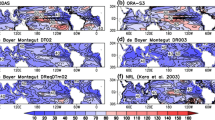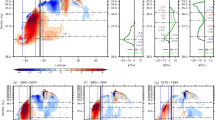Abstract
The equatorial undercurrent (EUC), the shallow meridional overturning cells feeding it, and their role in El Niño and decadal variability in the equatorial Pacific are studied using both in situ data and an ocean general circulation model. Using temperature and current data from the TAO/TRITON moorings at the equator, their data gaps are filled and it was shown that continuous time series of mass transport, temperature, depth, and kinetic energy of the EUC could be constructed for the period 1980–2002 with an excellent accuracy. This dataset was analysed and used to validate the output from an oceanic general circulation model (OGCM). The OGCM was then used to find that variations in the strength of the EUC, shallow meridional overturning (pycnocline convergence and surface divergence), and equatorial upwelling had the same variations in mass transport on interannual and longer time scales within the period 1951–1999. These variations are all caused by variations of the zonal wind stress zonally integrated, in agreement with simple linear and steady dynamics theories. Impact of these mass transport variations and of temperature variations on heat budgets in the entire equatorial band of the Pacific and in its eastern part are quantified.












Similar content being viewed by others
References
Alory G, Delcroix T (2002) Interannual sea level changes and associated mass transports in the tropical Pacific from TOPEX/Poseidon data and linear model results (1964–1999). J Geophys Res 107:C10 (10.1029/2001JC001067)
Alory G, Cravatte S, Izumo T, Rodgers K (2005) Validation of a decadal OGCM simulation for the tropical Pacific. Ocean Model 10:272–282
An S-I, Kang I-S (2000) A further investigation of the recharge oscillator paradigm for ENSO using a simple coupled model with the zonal mean and eddy separated. J Clim 13:1987–1993
Blanke B, Raynaud S (1997) Kinematics of the Pacific Equatorial Undercurrent: an Eulerian and Lagrangian approach from GCM results. J Phys Oceanogr 27:1038–1053
Bryden HL, Brady EC (1985) Diagnostic model of the three-dimensional circulation in the upper equatorial Pacific Ocean. J Phys Oceanogr 15:1255–1273
Clarke AJ, Lebedev A (1996) Long term changes in the equatorial Pacific trade winds. J Clim 9:1020–1029
Cravatte S, Picaut J, Eldin G (2003) Second and first baroclinic Kelvin modes in the equatorial Pacific at intraseasonal timescales. J Geophys Res 108(C8):3266 (10.1029/2002JCOO1511)
Deser C, Alexander MA, Timlin MS (1996) Upper-ocean thermal variations in the North Pacific during 1970–1991. J Clim 8:1840–1855
Goodman P, Hazeleger W, de Vries P, Cane M (accepted) Pathways into the Pacific Equatorial Undercurrent: a trajectory analysis. J Phys Oceanogr
Gu DF, Philander SGH (1997) Interdecadal climate fluctuations that depend on exchanges between the tropics and extratropics. Science 275:805–807
Hayes SP, Mangum LJ, Picaut J, Sumi A, Takeuchi K (1991) TOGA TAO: a moored array for real-time measurements in the tropical Pacific ocean. Bull Am Meteorol Soc 72:339–347
Hazeleger W, de Vries P, van Oldenborgh GJ (2000) Do tropical cells ventilate the Indo-Pacific equatorial thermocline? Geophys Res Lett 28(9):1763–1766
Hazeleger W, Visbeck M, Cane M, Karspeck A, Naik N (2001) Decadal upper ocean temperature variability in the tropical Pacific. J Geophys Res 106:8971–8988
Hazeleger W, Seager R, Cane M, Naik N (2004) How can tropical Pacific ocean heat transport vary? J Phys Oceanogr 24:320–333
Izumo T, Picaut V, Blanke B (2002) Tropical pathways, equatorial undercurrent variability and the 1998 La Niña. Geophys Res Lett 29(22):2080–2083
Izumo T (2003) The equatorial undercurrent and associated mass and heat exchanges in the tropical Pacific: variability, links with El Niño–La Niña events. Ph.D. manuscript, available at http://tel.ccsd.cnrs.fr in French
Jin FF (1997a) An equatorial ocean recharge paradigm for ENSO. Part I: conceptual model. J Atmos Sci 54:811–829
Jin FF (1997b) An equatorial ocean recharge paradigm for ENSO. Part II: a stripped-down coupled model. J Atmos Sci 54:830–847
Johnson ES, McPhaden MJ (1993) On the structure of equatorial Kelvin waves in the Pacific Ocean. J Phys Oceanogr 13:608–625
Johnson GC (2001) The Pacific Ocean subtropical cell surface limb. Geophys Res Lett 9:1771–1774
Johnson GC, McPhaden MJ, Rowe GD, McTaggart KE (2000) Upper equatorial ocean current and salinity during the 1996–1998 El Niño–La Niña cycle. J Geophys Res 105:1037–1053
Johnson GC, McPhaden MJ, Firing E (2001) Equatorial Pacific ocean horizontal velocity, divergence, and upwelling. J Phys Oceanogr 31:839–849
Johnson GC, Sloyan BM, Kessler WS, McTaggart KE (2002) Direct measurements of upper ocean currents and water properties across the tropical Pacific Ocean during the 1990s. Prog Oceanogr 52(1):31–61
Kessler WS, McPhaden MJ, Weickmann KM (1995) Forcing of intraseasonal Kelvin waves in the equatorial Pacific. J Geophys Res 100(C6):10613–10631
Kistler R et al (2001) The NCEP/NCAR 50-year reanalysis. Bull Am Meteorol Soc 82:247–268
Kleeman R, McCreary JP Jr, Klinger BA (1999) A mechanism for the decadal variation of ENSO. Geophys Res Lett 26:1743–1746
Klinger BA, McCreary JP, Kleeman R (2002) The relationship between oscillating subtropical wind stress and equatorial temperature. J Phys Oceanogr 32:1507–1521
Kug J-S, Kang I-S, An S-I (2003) Symmetric and antisymmetric mass exchanges between the equatorial and off-equatorial Pacific associated with ENSO. J Geophys Res 108(C8):3284
Lee T, Fukumori I (2003) Interannual to decadal variation of tropical–subtropical exchange in the Pacific Ocean: boundary versus interior pycnocline transports. J Clim 16:4022–4042
Liu Z, Philander SHG, Pacanowski RC (1994) A GCM study of tropical–subtropical upper-ocean water exchange. J Phys Oceanogr 24:2606–2623
Liu P, McCreary JP, Klinger BA (1998) Meridional circulation cells and the source waters of the Pacific equatorial undercurrent. J Phys Oceanogr 28:62–64
Madec G, Imbard M (1996) A global ocean mesh to overcome the North Pole singularity. Clim Dyn 12:381–388
Madec G, Delecluse P, Imbard M, Levy C (1998) OPA 8.1 Ocean General Circulation Model reference manual. Notes du pôle de modélisation de l’IPSL, vol 11, 91pp (available from http://www.lodyc.jussieu.fr/opa)
McCreary JP, Lu P (1994) Interaction between the subtropical and equatorial ocean circulations—the subtropical cell. J Phys Oceanogr 24:455–497
McPhaden MJ (1986) The equatorial undercurrent: 100 years of discovery. Eos 67(40):762–765
McPhaden MJ (1993) Trade wind fetch related variations in equatorial undercurrent depth, speed, and transport. J Geophys Res 98:2555–2559
McPhaden MJ, Yu X (1999) Equatorial waves and the 1997–98 El Niño. Geophys Res Lett 26:2961–2964
McPhaden MJ, Zhang D (2002) Slowdown of the meridional overturning circulation in the upper Pacific Ocean. Nature 415:603–608
McPhaden MJ et al (1998) The Tropical Ocean Global Atmosphere (TOGA) observing system: a decade of progress. J Geophys Res 103:14169–14240
Meinen CS, McPhaden MJ (2000) Observations of warm water volume changes in the equatorial Pacific and their relationship to El Niño and La Niña. J Clim 13:3551–3559
Meinen CS, McPhaden MJ (2001) Interannual variability in warm water volume transports in the equatorial Pacific during 1993–1999. J Phys Oceanogr 31:1324–1345
Meinen CS, McPhaden MJ, Johnson GC (2001) Vertical velocities and transports in the equatorial Pacific during 1993–99. J Phys Oceanogr 31:3230–3248
Nonaka M, Xie S-P, McCreary JP (2002) Decadal variations in the Subtropical Cells and equatorial Pacific SST. Geophys Res Lett 29, 10.1029/2001GL013676
Picaut J, Tournier R (1991) Monitoring the 1979–1985 equatorial Pacific current transports with bathythermograph data. J Geophys Res 96:3263–3277
Pierce D, Barnett T, Latif M (2000) Connections between the Pacific ocean tropics and midlatitudes on decadal timescales. J Clim 13:1173–1194
Putman WM, Legler DM, O’Brien JJ (2000) Interannual variability of synthesized FSU and NCEP-NCAR reanalysis pseudostress products over the Pacific Ocean. J Clim 13:3003–3016
Rodgers KB, Blanke B, Madec G, Aumont O, Ciais P, Dutay J-C (2003) Extratropical sources of Equatorial Pacific upwelling in an OGCM. Geophys Res Lett 30 (10.1029/2002GL016003)
Schneider NS, Miller AJ, Alexander MA, Deser C (1999) Subduction of decadal North Pacific temperature anomalies: observations and dynamics. J Phys Oceanogr 29:1056–1070
Sloyan BM, Johnson GC, Kessler WS (2003) The Pacific cold tongue: an indicator of hemispheric exchange. J Phys Oceanogr 33(5):1027–1043
Springer SR, McPhaden MJ, Busalacchi AJ (1990) Oceanic heat content variability in the tropical Pacific during the 1982–1983 El Niño. J Geophys Res 95:22089–22101
Sun D-Z (2000) The heat sources and sinks of the 1986-87 El Niño. J Clim 13:3533–3550
Sun D-Z (2003) A possible effect of an increase in the warm-pool SST on the magnitude of El Niño warming. J Clim 16:185–205
Wu R, Xie S-P (2003) On equatorial Pacific surface wind changes around 1977: NCEP-NCAR reanalysis versus COADS observation. J Clim 16:167–173
Wyrtki K (1985) Water displacements in the Pacific and the genesis of El Niño cycles. J Geophys Res (C Oceans) 90:7129–7132
Yu X, McPhaden MJ (1999a) Seasonal variability in the equatorial Pacific. J Phys Oceanogr 29:925–947
Yu X, McPhaden MJ (1999b) Dynamical analysis of seasonal and interannual variability in the equatorial Pacific. J Phys Oceanogr 29:2350–2369
Zebiak S (1989) Oceanic heat content variability and El Niño cycles. J Phys Oceanogr 19:475–486
Acknowledgments
I would first like to thank Joël Picaut (now retired), who followed this work as my Ph.D. advisor, for all his enthusiam and his great knowledge. I would also like to thank in particular B. Blanke for his following of this work and the many productive discussions, M.J. McPhaden, G. Reverdin, and Y. Tourre for their careful lecture of the Ph.D. manuscript (available in line at http://tel.ccsd.cnrs.fr) associated to this work and their precious comments. I would like to thank G. Alory and G. Lorand for the outputs of the OPA model, forced with NCEP winds and with ERS winds, respectively, and G. Johnson for the in situ data for the EUC, used in the present analysis. I would also like to thank PMEL staff for their work on TAO data (available at http://www.pmel.noaa.gov) and for the development of the very useful Ferret software. Support for this work was provided by the French Department of Education, Research and Technology, CNES, IRD and PNEDC.
Author information
Authors and Affiliations
Corresponding author
Rights and permissions
About this article
Cite this article
Izumo, T. The equatorial undercurrent, meridional overturning circulation, and their roles in mass and heat exchanges during El Niño events in the tropical Pacific ocean. Ocean Dynamics 55, 110–123 (2005). https://doi.org/10.1007/s10236-005-0115-1
Received:
Accepted:
Published:
Issue Date:
DOI: https://doi.org/10.1007/s10236-005-0115-1
Keywords
- Equatorial undercurrent (EUC)
- El Niño Southern Oscillation (ENSO)
- Shallow subtropical/tropical meridional overturning cells (STCs/TCs)
- Equatorial upwelling
- Mass and heat transport
- Heat budget
- Recharge/discharge mechanism
- Interannual and decadal variations of the tropical Pacific
- Climate change
- TAO/TRITON moorings
- Ocean general circulation model (OGCM)




